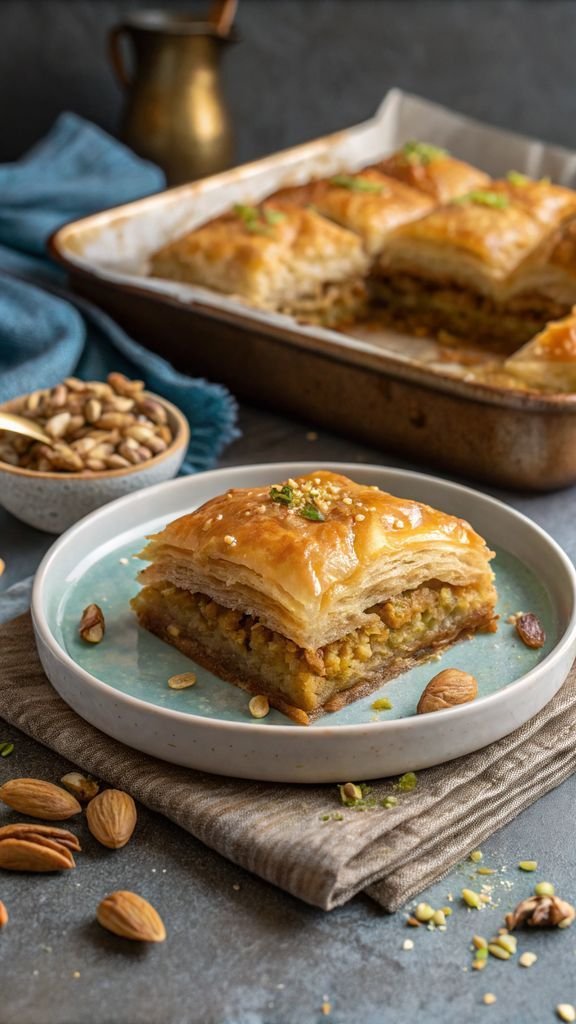Baklava: A Sweet Journey Through Layers of History and Flavor
Few desserts capture the essence of Mediterranean hospitality like baklava. This iconic pastry—crisp, golden layers of paper-thin phyllo embracing spiced nuts, drenched in aromatic syrup—is more than just a sweet treat; it’s an edible tapestry woven with centuries of history. Believed to have originated in the imperial kitchens of the Ottoman Empire, baklava’s roots stretch across Turkey, Greece, Lebanon, and beyond, with each region adding its signature touch. I first fell in love with baklava during a trip to Istanbul, where bustling bazaar vendors would stack honey-drenched diamonds in glowing pyramids. The first bite was a revelation: shatteringly crisp yet yielding, sweet but balanced by earthy nuts, perfumed with citrus and spice. Beyond its addictive texture and flavor, baklava carries deep cultural significance. It’s served during Eid, Christmas, weddings, and celebrations as a symbol of abundance and goodwill. The labor-intensive process—requiring patience and precision—makes it an act of love, a dessert that says, “You’re worth the effort.” While it might seem intimidating, my tested recipe breaks it down into achievable steps. As you’ll see in the image below, the result is a masterpiece that glistens like a jewel box, promising a bite of history in every layer.

Why You’ll Love This Recipe
- Unbeatable Texture Symphony: Experience the magic of crisp phyllo shattering to reveal tender, spiced nuts, all bound by a silky syrup that seeps into every crevice.
- Crowd-Pleasing Elegance: Visually stunning and universally adored, baklava turns any gathering into a special occasion. One glance at the golden, nut-filled layers (like in our featured photo) guarantees “wows” from guests.
- Make-Ahead Magic: Unlike fussy desserts requiring last-minute assembly, baklava’s flavor deepens as it rests. Bake it days ahead and savor the stress-free hosting.
- Customizable Canvas: Swap nuts, adjust spices, or infuse syrups to make it your own—while staying true to its soul-satisfying essence.
Ingredients
Quality matters here—especially with nuts and phyllo. Opt for fresh, high-grade ingredients:
– Phyllo dough: 1 lb (about 40 sheets), thawed overnight in the fridge. Keep it sealed until use to prevent drying.
– Unsalted butter: 1 ½ cups (340g), melted and cooled. Use European-style for richer flavor.
– Walnuts: 2 ½ cups (300g), raw and unsalted. Toast lightly for depth.
– Pistachios: 1 ½ cups (180g), raw and unsalted. Reserve 2 tbsp for garnish.
– Granulated sugar: 1 cup (200g) for nut filling + 1 ½ cups (300g) for syrup.
– Ground cinnamon: 1 ½ tsp. Ceylon cinnamon preferred for its floral notes.
– Ground cloves: ¼ tsp (optional but classic).
– Lemon zest: From 1 lemon (about 1 tsp). Brightens the syrup.
– Honey: 1 cup (340g). Use orange blossom honey for authenticity.
– Water: 1 cup (240ml) for syrup.
– Fresh lemon juice: 2 tbsp. Balances sweetness.
– Orange blossom water: 1 tsp (optional but recommended). Find it in Middle Eastern markets.
Equipment Needed
- 9×13-inch metal baking pan
- Pastry brush (silicone for easy cleaning)
- Sharp chef’s knife or serrated bread knife
- Food processor (for nuts)
- Large cutting board
- Saucepan (medium-sized)
- Fine-mesh strainer
- Kitchen towel or plastic wrap (to keep phyllo moist)
- Measuring cups/spoons
- Oven thermometer (critical for even baking)
Step-by-Step Instructions
Total time: 1 hour prep + 1 hour bake + 6 hours rest | Serves 24
-
Prep the Nuts: Pulse walnuts and pistachios (minus reserved garnish) in a food processor until coarsely chopped—not powder! Mix with 1 cup sugar, cinnamon, cloves, and lemon zest. Set aside.
Tip: Freeze nuts for 10 minutes first to prevent oiliness. -
Make the Syrup: Combine 1 ½ cups sugar, water, honey, and lemon juice in a saucepan. Simmer over medium heat for 10 minutes, stirring until sugar dissolves. Remove from heat; stir in orange blossom water. Cool completely. Syrup must be cool when poured over hot baklava!
-
Butter the Pan: Brush bottom and sides of the baking pan with melted butter.
-
Layer the Phyllo: Unroll thawed phyllo. Cover with a damp towel to prevent drying. Place 1 sheet in the pan; brush lightly with butter. Repeat until you have 10 buttered sheets. Work quickly—phyllo dries fast! As shown in our image, each layer should glisten but not swim in butter.
-
Add Nut Filling: Sprinkle 1/3 of the nut mixture evenly over the phyllo.
-
Middle Layers: Add 6 more phyllo sheets, buttering each one. Top with another 1/3 nuts. Repeat with 6 more buttered sheets and remaining nuts.
-
Top Phyllo Layer: Finish with 10-12 phyllo sheets, buttering each one generously. Press down gently.
-
Pre-Cut Baklava: Using a sharp knife, cut diagonal lines 1.5 inches apart to create diamond shapes. Cut all the way to the bottom. Pro tip: Wipe the knife between cuts for cleaner edges.
-
Bake: Preheat oven to 325°F (165°C). Bake for 50-60 minutes until golden brown. Rotate pan halfway through. Oven temps vary—use a thermometer!
-
Syrup It Hot: As soon as baklava exits the oven, pour cooled syrup evenly over the top. It will sizzle dramatically—that’s good!
-
Rest and Absorb: Let baklava cool uncovered at room temperature for at least 6 hours (or overnight). Resist cutting sooner—syrup needs time to soak in.
Tips for Perfect Results
- Phyllo Management: If sheets tear, patch with butter—it’s forgiving once layered.
- Butter Consistency: Melt butter until foamy but not browned. Skim off milk solids for clearer sheen.
- Nut Texture: Chop by hand if you prefer chunkier bites. Avoid pre-ground nuts—they turn pasty.
- Syrup Temperature: Pouring cool syrup over hot baklava ensures ideal absorption without sogginess.
- Clean Cuts: Score top layers lightly before baking, then cut fully after baking for neat diamonds.
Storage and Make-Ahead Instructions
- Room Temperature: Store covered at room temp for up to 2 weeks. No refrigeration needed!
- Freezing: Freeze unbaked baklava (wrapped tightly) for 3 months. Bake from frozen; add 15 minutes to time. Freeze baked baklava up to 6 months; thaw overnight before serving.
- Make-Ahead: Baklava tastes best 24-48 hours after assembly. Bake and syrup 1-2 days ahead.
Variations and Substitutions
- Nut-Free: Substitute seeds like sunflower or pumpkin (use 4 cups total). Add 1 tbsp sesame seeds for depth.
- Pistachio-Rose: Use all pistachios, add 1 tsp rose water to syrup, garnish with dried rose petals.
- Chocolate-Hazelnut: Replace walnuts with toasted hazelnuts; drizzle melted dark chocolate over cooled baklava.
- Sugar Adjustment: Reduce syrup sugar to 1 cup for less sweetness; boost lemon juice to 3 tbsp.
Maddy’s Tips for Success
From my 20+ baklava batches to yours:
– Chill Your Butter: Cold butter thickens faster when brushing, preventing phyllo from tearing.
– The Fold Trick: If phyllo sheets are larger than your pan, butter and fold edges inward to fit.
– Syrup Safety Test: Drop a bit of syrup in cold water. If it forms a soft thread, it’s ready.
– Even Baking: Place pan on a preheated pizza stone to crisp the bottom layer.
– Garnish Wisely: Sprinkle crushed pistachios after adding syrup—they’ll stay vibrant green.
Frequently Asked Questions
Can I use store-bought phyllo?
Absolutely! Just ensure it’s fully thawed. Homemade phyllo is labor-intensive and unnecessary for great results.
Why did my baklava turn soggy?
Likely causes: Syrup was too hot when poured, underbaking, or cutting before full cooling. Always cool syrup and baklava properly!
Can I use olive oil instead of butter?
Traditionalists insist on butter for flavor, but mild olive oil works. Avoid extra virgin—its taste overpowers.
How do I prevent nuts from burning?
Keep nuts raw before baking. The layers protect them during cooking. If top browns too fast, tent with foil.
Is baklava gluten-free?
Phyllo contains wheat, but gluten-free phyllo works well (adjust baking time—it browns faster).
Nutrition Information
Baklava is an indulgence, but its nuts offer silver linings: Walnuts provide omega-3s and antioxidants, while pistachios deliver protein and fiber. Portion control is key—one piece (about 80g) has ~330 calories. Enjoy mindfully with unsweetened tea to balance sweetness!
Serving Suggestions
- Classic Elegance: Serve diamonds on a white platter, garnished with finely crushed pistachios and edible rose petals. Pair with strong Turkish coffee or mint tea.
- Warm Comfort: Briefly microwave (10 seconds) and top with vanilla ice cream for a “baklava sundae.” The contrast of hot/cold is divine!
- Festive Platter: Include baklava in a Mediterranean dessert spread with ma’amoul (date cookies) and fresh figs. Drizzle extra honey for shine—as seen in our tempting image!
There you have it—the secrets to baklava that’ll transport your kitchen to the spice-scented alleys of Istanbul. Remember, the sizzle when syrup meets pastry isn’t just chemistry; it’s the sound of centuries-old culinary magic. Share it generously, savor it slowly, and let every layered bite tell a story. Happy baking! 🍯✨

